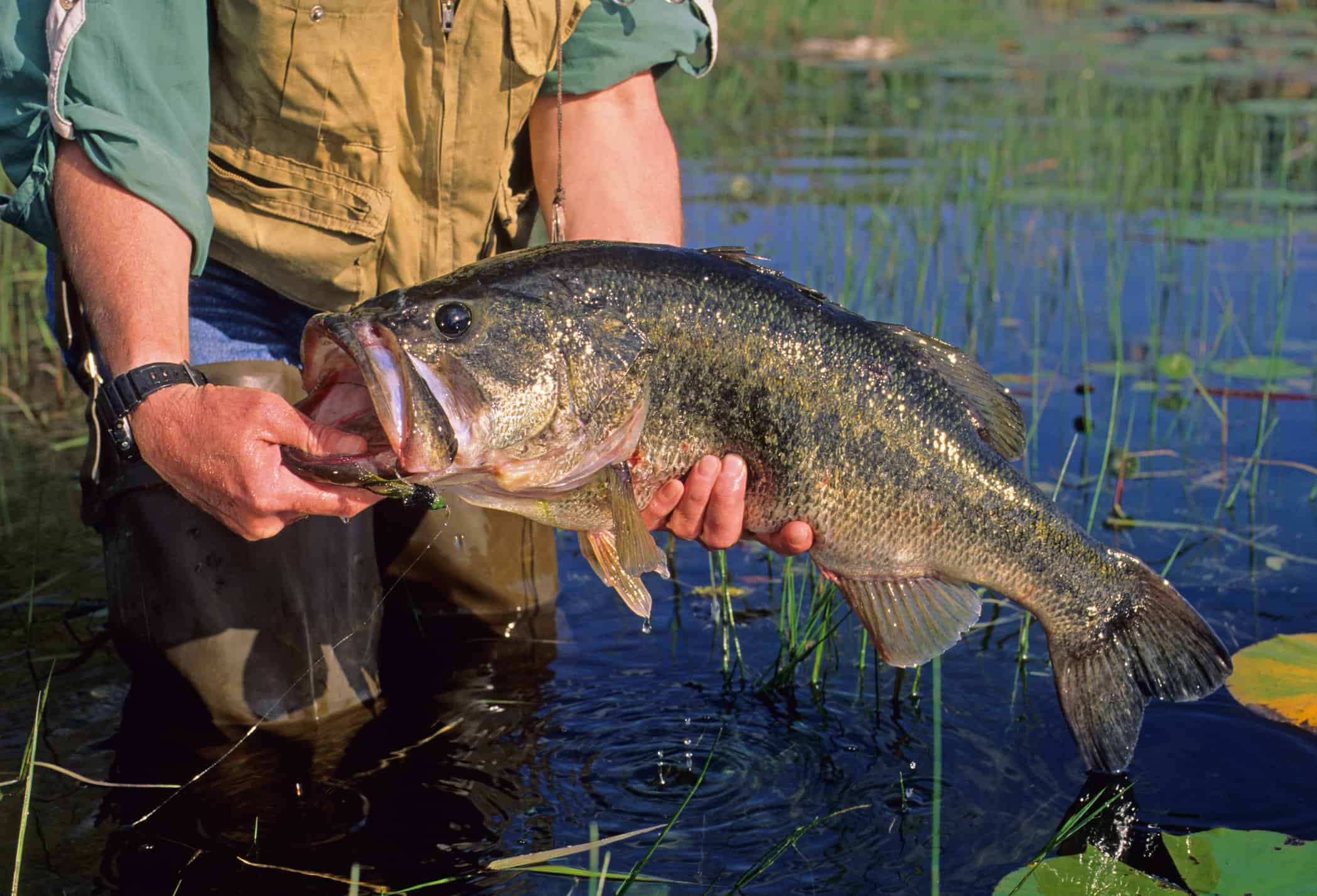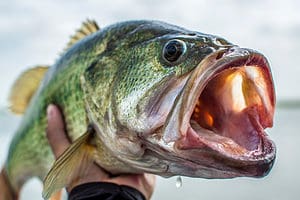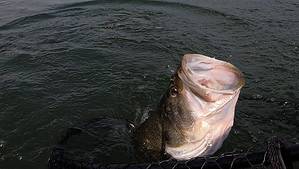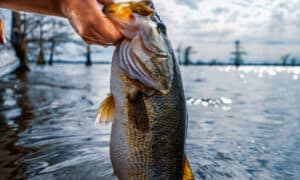One of the most coveted fishing records in the world is for the largemouth bass. With several organizations awarding incentives worth millions of dollars throughout the years, it may also be the most valued type of fish one can set their sights on.
One would assume it’s just a matter of time before a new record-setting bass is caught given these incentives. And that’s plus the fact that millions of fishermen hit the water each year. But thus far, it appears that time is on the side of the world record holders for largemouth bass.
Let’s take a look at the largest largemouth bass ever caught in the state of Idaho. We’ll also look at some more fascinating information about this fish and its history among fishermen.
What are Largemouth Bass?
In North America, the largemouth bass (scientific name Micropterus salmoides) is a popular freshwater game fish. It belongs to the Centrarchidae family of sunfish and is distinguished by its notably very large mouth. When its jaw is completely extended, it can extend past the eye.
The predatory fish known as the largemouth bass prefers clean, warm, weedy, and still rivers, lakes, and reservoirs. Its body is fashioned like a torpedo, which facilitates its swift movement through the water. This fascinating fish has a white belly, paler sides, and a back that is dark greenish-grey. It is distinguished by its big, wide mouth with an upper jaw that sticks out past the eye that is filled with pointed teeth. Although the largemouth bass may live up to 16 years, the average lifespan is closer to 10 years.
As predators, largemouth bass can consume a wide range of food items, including small fish, crayfish, frogs, and insects. Being opportunistic eaters, they will consume nearly everything that will fit in their mouths. Largemouth bass that are still young mostly eat zooplankton, but as they become older they start to eat bigger prey. Because of its keen vision, the largemouth bass can find food even when it is dark outside.
Largemouth bass normally spawn in the spring when the water is between 60 and 75 degrees F. Typically, males construct nests in shallow water, which they guard against other males and predators. The males fertilize the eggs after the females place them in the nest. The males then watch over the eggs until they hatch. Depending on the water’s temperature, this can take anywhere from five to 10 days. The larvae live on their yolk sac for a few days following hatching. Then, they begin swimming to the water’s surface to eat zooplankton.
Fishing for Largemouth Bass
Due to their size and battling prowess, largemouth bass are a popular game fish and are sought after by fishermen around the world. They are difficult to catch because of their reputation for launching powerful blows and acrobatic leaps. Fishing methods such as baitcasting, spinning, and fly fishing can all be used to catch largemouth bass. Lures like plastic worms, crankbaits, and topwater lures are frequently used to catch these fish.
Largemouth bass are now regarded as an invasive species in certain locations after being introduced to a few different nations outside of North America. By competing with native fish populations for food and habitat, they could have detrimental effects if their populations are not controlled. They occasionally have the ability to hybridize with closely related species, which can lead to genetic pollution. That being said, in North America’s freshwater environments, the largemouth bass is a significant species and an essential component of the food chain.
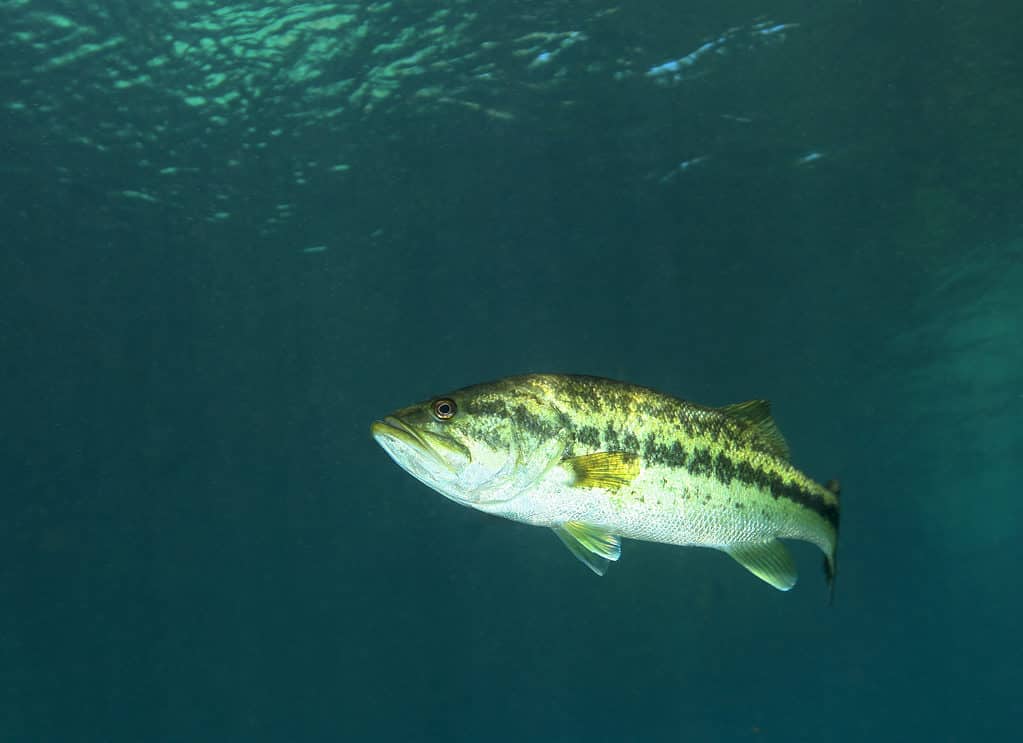
Largemouth bass (pictured) are known for having a large mouth that can protrude far past its eyes.
©iStock.com/mpwoodib
Typical Size of Largemouth Bass
A largemouth bass’s size can vary significantly depending on its age, nutrition, and environment. A mature largemouth bass can weigh up to 10 pounds and grow up to 22 inches long on average. Larger specimens, on the other hand, can grow to a length of up to 29 inches and a weight of up to 22 pounds.
In largemouth bass, there are also disparities in size between the sexes. With an average weight of two to three pounds compared to a male’s one to two pounds, females often weigh more than men. This occurs as a result of females developing more and bigger eggs than men due to their greater energy expenditure during reproduction.
A largemouth bass’s size might differ geographically as well. The shorter growing season in northern locations may prevent fish from developing to the same size as those in southern regions. In addition to this, fish living in perfect circumstances and regions with plenty of food sources could become bigger than fish living in unfavorable situations.
Depending on their age, juvenile largemouth bass can range in size. In general, hatchlings are around a quarter inch long. During the first year of life, they grow quickly and often reach a length of four to five inches as juveniles. They may grow to lengths of eight to 12 inches by the end of their second year, and they can grow as long as 16 inches by the end of their third year.
The History of Fishing for Largemouth Bass
The history of largemouth bass fishing in North America dates back to the late 19th century. This is when the species began to gain popularity as a game fish. In 1874, the first recorded instance of largemouth bass being intentionally stocked in a body of water occurred in California, where smallmouth bass were also introduced. Shortly after, largemouth bass were introduced to other regions of the country, including Florida, Texas, and the northeastern United States.
The popularity of largemouth bass fishing continued to grow throughout the 20th century. In the 1930s, the development of new fishing gear and techniques, such as the use of artificial lures, made fishing for largemouth bass more accessible to a wider audience. This led to an increase in the number of anglers targeting largemouth bass, and the species quickly became one of the most sought-after game fish in North America.
Today, largemouth bass fishing remains a popular pastime for anglers of all skill levels. Many factors contribute to the continued popularity of largemouth bass fishing. For one, the species is widely distributed throughout North America, making it easily accessible to anglers in many regions. Additionally, largemouth bass are known for their fighting ability and acrobatic jumps, making them truly thrilling fish to catch. They are also one of the largest freshwater game fish, which adds to their appeal.
The Value of Largemouth Bass Fishing
In addition to their recreational value, largemouth bass also play an important ecological role in freshwater ecosystems. They are top predators and help to control the populations of smaller fish and other aquatic organisms. They also serve as an important food source for many other species, including birds and larger fish.
To summarize, the history of largemouth bass fishing in North America dates back to the late 19th century. The species has since become one of the most popular game fish in the United States. Its popularity is due to a variety of factors, including accessibility, fighting ability, and size. Furthermore, largemouth bass play an important ecological role in freshwater ecosystems, highlighting the importance of sustainable fishing practices to ensure their continued survival.

Largemouth bass (pictured) are popular fish for anglers because of the fight they put up and their difficulty in successfully catching.
©iStock.com/stammphoto
The History of Fishing for Largemouth Bass in Idaho
Compared to other parts of the country, Idaho’s history of largemouth bass fishing is relatively new. Largemouth bass weren’t introduced to Idaho waterways until the 1950s. Since then, fishing for largemouth bass has gained popularity among fishermen in the state.
In an effort to increase the variety of game fish found in the state’s waters, largemouth bass were first brought to Idaho in the 1950s. Largemouth bass were stocked for the first time at C.J. Strike Reservoir, and since then, the species has been spread to a number of additional bodies of water around the state.
As more fishermen started to pursue the species in the 1960s and 1970s, largemouth bass fishing in Idaho started to gain appeal. Along with trout and steelhead, largemouth bass was one of the most sought-after game fish in the state by the 1980s.
The Popularity of Largemouth Bass in Idaho
Fishing for largemouth bass is quite popular in Idaho for a number of reasons. One reason the species is exciting to catch is because it is renowned for its fighting prowess and acrobatic leaps. Additionally, because largemouth bass are abundant across the state, fishermen in many areas may easily catch them.
The state of Idaho’s warm climate permits year-round fishing possibilities. It has also contributed to the popularity of largemouth bass fishing there. This implies that even during the winter, when other species may be less active, fishermen can target largemouth bass.
Largemouth bass fishing is still a favorite activity for fishermen in Idaho today. Many of the state’s bodies of water are renowned for their largemouth bass concentrations. These include bodies of water like C.J. Strike Reservoir, Brownlee Reservoir, and Lake Lowell.
In addition to being valuable for entertainment, largemouth bass are crucial to the health of Idaho’s freshwater ecosystems as well. Since they are top predators, they aid in regulating the populations of other aquatic animals including smaller fish. Just as well, they provide a vital source of food for several other species, such as birds and larger fish.
The Controversy Behind Largemouth Bass in Idaho
It’s crucial to remember that the introduction of largemouth bass to the lakes of Idaho wasn’t without controversy. Concerns regarding the possible effects of invasive species on native fish populations and the overall health of Idaho’s aquatic ecosystems have been voiced by some conservationists.
As we mentioned earlier, Idaho’s history of largemouth bass fishing is relatively new compared to those of other parts of the country. However, since its introduction in the 1950s, largemouth bass have grown in popularity as one of the state’s most sought-after game species. Their popularity is a result of a number of things, such as accessibility, combat prowess, and a temperate environment. Furthermore, largemouth bass are crucial to the ecology of Idaho’s freshwater environments. That being said, appropriate management and sustainable fishing methods can assure their long-term survival in the waters of Idaho.
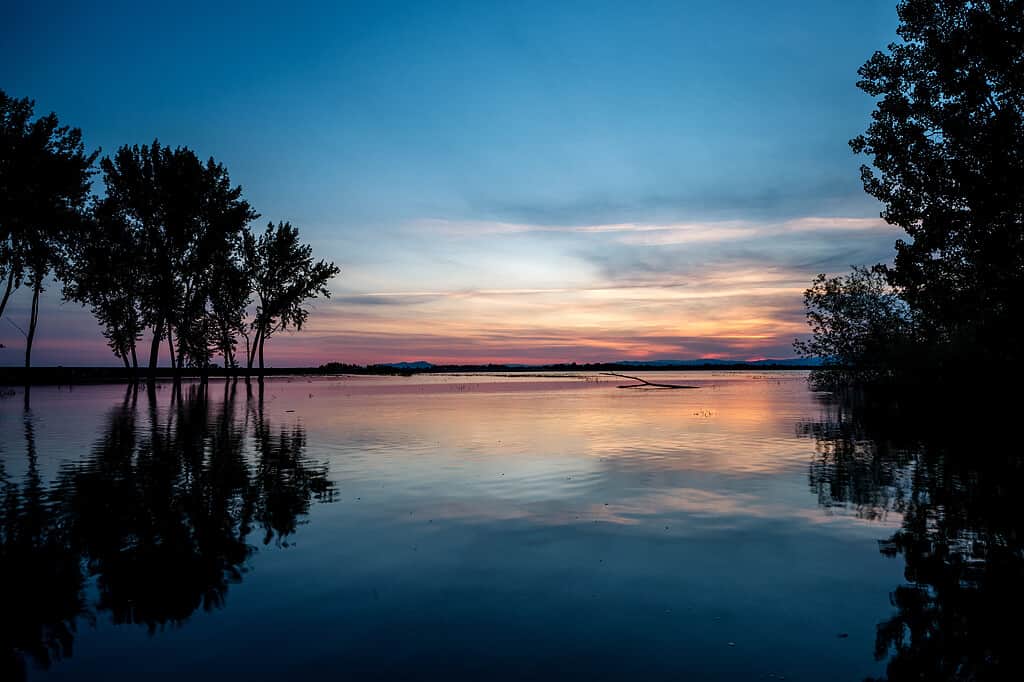
Idaho state lakes like Lake Lowell (pictured) are popular destinations for fishermen who wish to catch largemouth bass.
© Charles Knowles /Shutterstock.com
The Largest Largemouth Bass Ever Caught in Idaho
As it currently stands, the largest largemouth bass ever caught in the state of Idaho was a whopping 10.94 pounds. The catch’s length and weight was never recorded. However, we do know that the beast was caught by a Mrs. M.W. Taylor from Anderson Lake. Anderson Lake is located in Kootenai County, Idaho and is 541.1 acres long.
Outside of this record noted by the Certified Weight Fish Records from the Idaho Fish and Game website, little is known about Idaho’s competing largemouth bass catches. That being said, stories of largemouth bass measuring over 10 pounds being captured in Idaho waterways have surfaced, especially in C.J. Strike and Brownlee reservoirs. These reports, nevertheless, are unofficial and not acknowledged as state records. They are simply anecdotal.
Furthermore, it’s important to remember that the size of largemouth bass can vary significantly based on their age, food, and other environmental conditions. Anglers can still experience the excitement of pursuing these powerful game fish in the state of Idaho’s waterways even though the largest largemouth bass ever captured in Idaho may not have been officially documented.
The Largest Largemouth Bass Ever Caught in the World
Around 89 years ago, on June 2nd, 1932, George Perry caught the world’s largest largemouth bass. The 22-pound, four-ounce monster of a fish presently holds the world record at Montgomery Lake in Georgia. The details of that day and that fish are shrouded in mystery.
Perry and a friend had only had one rod between them, and they were on a meat run when they discovered enough fish in one bite to feed Perry’s family of six for two days. At the time, food was limited, so the concept of merely fishing for enjoyment sounded absurd.
We only have a few glances of the largest bass ever officially recognized by the International Fish and Game Administration. The IFGA is the agency that oversees world records and other fish and game-related things, from a time way before cellphones. The world-record bass was grandfathered in as the largest fish ever when the IFGA was established seven years after Perry’s catch. The record has been kept ever since, and no one has officially caught a largemouth bass larger than Perry’s catch.
The Record’s Closest Competitor
Manabu Kurita, a Japanese fisherman, had the most success (so far) in bringing down George’s Goliath of a bass. Even yet, some would even claim Kurita was successful in completing the difficult assignment. Kurita caught a 22-pound, five-ounce largemouth bass on July 2nd, 2009 while fishing in Lake Biwa, Japan. That’s right; 22 pounds and five ounces is certainly an ounce heavier than Perry’s catch. Unfortunately, there is a catch. The IFGA stipulates that a fish must weigh a full two ounces more in order to be recognized as a brand-new world record. In terms of weight, Perry and Kurita are now officially tied for the largest largemouth bass ever caught.
Since Kurita’s capture, Lake Biwa has attracted a lot more attention and become a renowned fishing spot. Because largemouth bass were introduced to Japan throughout the years and have since been stocked in a number of fisheries, Kurita’s monster catch and the lake it came from have become the subject of intrigue.
Largemouth bass are really fascinating fish. They are a ton of fun to fish for. While you might not break any world records easily, enjoying a fishing trip with the goal of catching a largemouth bass is certainly worth it.
Where is Anderson Lake Located on a Map?
Located in Idaho with the zip code 83833, Anderson Lake offers a picturesque setting for outdoor enthusiasts. Discover directions, get an overview, read reviews, browse through photos, and even contribute your own review and rating to share your personal experience of this captivating destination.
Here is Anderson Lake on a map:
Thank you for reading! Have some feedback for us? Contact the AZ Animals editorial team.

